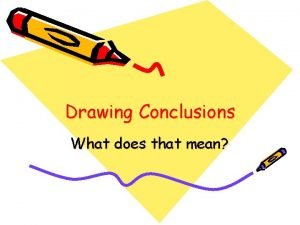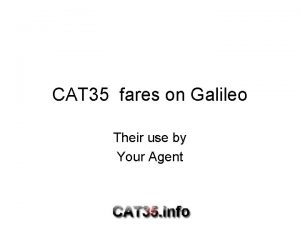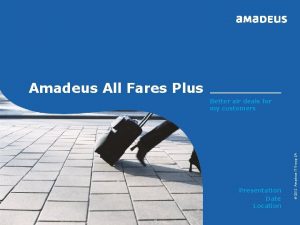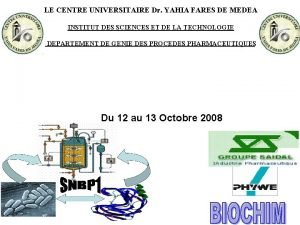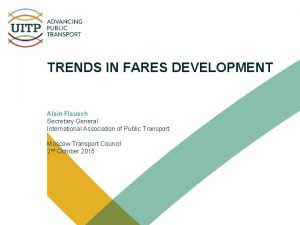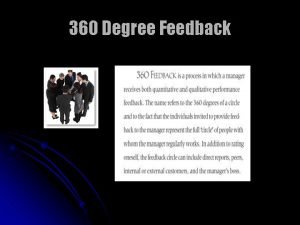GALILEO 360 FARES AND SHOPPING WHITE PAPER FARES






- Slides: 6

GALILEO 360° FARES AND SHOPPING WHITE PAPER FARES AND SHOPPING CRACKING THEPAPER CODE GALILEO 360° FARES AND–SHOPPING WHITE Admit it. You’ve done it. We’ve all done it at some point. We’ve sat through a presentation, participated in a discussion or read a product brochure about fares, faring systems, shopping logic, tariff rules and the like and smiled and nodded as if we knew what was being said. Surcharges, plus-ups, mileage bands, routing restrictions, global indicators – its all very simple really. For most of us, the ability to diagram a fare, determine its accuracy and applicability to a given a itinerary and understand the various dependant documentation entries required to make sure that the ticketed fare passes the scrutiny of the airline who carried your passenger is about as intuitive as quantum physics, only without the fun. So as an agency owner or decision maker evaluating the relative merits of various faring systems, how are you to know the difference between scattering and resonances, analogies in optics, quantized angular momentum, distinguishable and indistinguishable particles? Since those terms are only relevant in quantum physics, let’s stick with fares for now. At Galileo we are investing millions of dollars and developer programming hours to build a faring system that we think is the best in the industry. We call it Galileo 360° Fares, and as the name infers, it covers the entire fares spectrum, from public to private to web fares. It also has a new feature, Optimal Shopping, that we are sure is going to make a big difference in the way you find airfares for your customers. “Galileo 360 °Fares now supports more ATPCO automated rules, routing and footnote products than any other GDS Fares System…” THAT WAS THEN…THIS IS NOW Prior to the retirement of “res cards” and paper tariffs from airline ticket offices in the early 1970 s, everything about the airline booking process was manual. The airlines kept track of their inventory with large wall mounted, slate tracking panels like scoreboards. When a seat was sold, the inventory controller erased the previous seat count and wrote the new number on the chalkboard. What is the fare? The airline agent walked over to the tariff book, which usually sat on a desk about eight feet long, and found the fare printed in the book and returned to advise the travel agent. The agent would then hand-write the ticket for the reservation just created, enter the fare details and the passenger would be on his or her way. Ask anyone who worked in the business during those carefree times and they’ll no doubt wax poetic about what is known as “BC” – before computers. Today, there is no such thing as “the fare. ” There are millions of fares, updated around the clock from airlines all over the world. They can be simple and straightforward – one-way, first class, New York to Los Angeles or they can be complex, such as a 25% discount off of the lowest unrestricted economy fare from zone 1 to zone 3. In any given market, on any given carrier, there could be upwards of 75 to 100 possible fares that apply. When deregulation came to airline industry in 1978, price and not service became the driving market factor the differentiates carriers from each other. So what does deregulationj have to do with choosing a fares system? Plenty. 1

GALILEO 360° FARES AND SHOPPING WHITE PAPER THE PRICE AS THE PRODUCT WHITEEach GDS has developed over time faring and PAPER Like it or not, for the most part, there is very little difference in service among airlines in 2004, especially in the North American domestic markets. In a pricedriven marketplace, carriers engage in a scientific practice known as yield management. The goal of yield management is to ensure that every flight that takes off is profitable, and the fares that passengers pay has a great deal to do with that. Fuel, landing fees, salaries and yes, GDS distribution costs all factor into the profitability model as well. Meanwhile, back at the agency, the travel management company has evolved and transformed its business model to accommodate the roller-coaster economics of the airline industry. It is almost unfathomable to think that a business that depended 100% on supplier commissions was able to watch those commissions whither to zero and replace that revenue with service and management fees, but that is exactly what was achieved by the agency community. Their value proposition of travel consultant and advocate for the customer in the complex world of travel pricing that marked the end of the last decade and continues today, was firmly established – your travel agent, using their GDS, could find you the best fare. 4 Q 04 pricing systems that handle message volume and calculations never dreamed of 25 years ago. As the market demands changed, so did their systems and their respective approach to management of the fares and pricing challenge. To supplement the basic automation, the GDS companies staffed hundreds of employees dedicated to the function of taking fares, rules and routings from a piece of paper or electronic transmission from the carrier or filing company, interpreting what they meant, and entering them into the pricing system so that agencies could have access to them. So in the end, the machinery behind this myriad and complex fares system came down to a human being entering data into a computer. And for some GDS systems, especially in the area of negotiated rates, that is exactly how it is done today. For some, yes. But not for Galileo. The goal of Galileo 360° fares is simple – 100% fares automation. The chart below shows how far we’ve come in reaching our goal of 100% automation Intl Public Phase 3 Oct. 2004 2 Q and 3 Q 04 1 Q 04 International Public Phase 2 July 2004 100% Automation Agency Private Phase 2 July 2004 International Public Phase 1 February 2004 North American Public Fares North American Private Fares International Private Fares Agency Private Fares Phase 1 2

GALILEO 360° FARES AND SHOPPING WHITE PAPER WHAT DOES 100% AUTOMATION MEAN TO ME? As the diagram below illustrates, all fares follow the same circular process in that they begin and end with the supplier or travel provider. In a 100% automated environment, each of the phases of deployment and implementation past the intermediary stage is free of manual intervention by the distributor (in this case, the GDS) or the agency. What this accomplishes is a fares distribution model that eliminates agent responsibility and errors because the provider of the fare is the same entity as the auditor; in this case, the airline. In fact, because of the significant reduction in errors, four air carriers in North America have agreed to a direct debit memo resolution procedure with Galileo on all auto-priced tickets. This procedure will considerably reduce the number of debit memos that an agency must process, which in the end results in huge cost savings and increased productivity by diverting resources away from this labor-intensive activity. By automating 100% of the fares process, the column on the right lists a few ways in which Galileo 360° Fares will save time and money: Advantages of Galileo 360° Fares : q Virtual elimination of debit memos q Improved faring accuracy and productivity q No manual entries for ticket endorsements q More Galileo-guaranteed fares than ever q Improved handling of surcharges q Fast fare loading allows immediate access , especially for short-lived fares q Flexible framework accommodates industry changes and mandates easily and quickly q Airline filing of negotiated fares reduces agency risk because Airline Private Fares are guaranteed – discrepancies are the responsibility of the airline. q Shop a broader range of fares – public, private, web, consolidator through an integrated interface. q Airline filing of private fares results in reduced agency management and administration of negotiated fares. q Ability to retrieve fares and rules for up to 90 days to assist with refunds, reissues, and billings. ARC/BSP Agency Source “Negotiated Fares, Pricing and Fare Distribution” Presented at 2003 Interline Sales and Marketing Conference, Ocho Rios, Jamaica – November 2003 Galileo Preferred Fares Select Carriers q The most competitive fares, including web fares and specials, are available from our Preferred Fares Select carriers; American, Continental, Delta, Northwest, United and US 3 Airways

GALILEO 360° FARES AND SHOPPING WHITE PAPER AIRLINE PRIVATE FARES For agencies with negotiated rates, our automated negotiated fares product, Airline Private Fares, provides automation that will streamline the entire negotiated fares process and virtually eliminate the possibility of errors. There are two basic types of negotiated fares available via Airline Private Fares: 1. Specified private fares: fares filed in specific markets having specific rule provisions 2. Formula based private fares: percent (or specified) formulas to be applied to existing specified fares that result in a unique private fare. Galileo has added and/or augmented the following rules categories that support these and other fare types: Category 25 – Fare by Rule Category 35 – Negotiated Fares Galileo has taken great strides to create and maintain the best in breed fares system, ensuring accuracy and ease of use for our agency customers. A world-class faring system, however, does not provide 100% of the pricing functionality that today’s agencies require. If the fares shopping engine that accesses these fares has functionality restrictions, inherent limitations or is just poorly thought through, the ability to apply these fares to a set of flights falls apart and the investment becomes for naught. Combined with the most accurate fares, you need the best shopping tools. And a big part of that is the heuristic deployed. WHAT’S IN A HEURISTIC? Better yet, what IS a heuristic and why should you care. Generally speaking, a heuristic is a rule (or set of rules) intended to increase the probability of solving a particular problem. In fares shopping, it is the set of search parameters that the computer application uses to hunt and gather through the universe of potential flight options to arrive at the “best” fare. Which begs the question, what is the “best” fare? What are the criteria that make one set of flight options better than another? Who decides? Up until now, the GDS or the airline decided. The shopping heuristic is a defined set of parameters that sets one pricing engine apart from another. That is why, given a set of dates and cities, different systems will arrive at different fares given exactly the same data to work with. So which one is correct? They all are. Which one is the “best? ” That depends. Do you want a nonstop or are you willing to connect twice? If you wanted to depart at noon but the lowest fare found is on an overnight flight, do you want that one, or should we try to find the lowest fare near the noon timeframe. Clearly, the definition of the best fare is as different as the person evaluating the itinerary matching up to that fare 4

GALILEO 360° FARES AND SHOPPING WHITE PAPER HEURISTICS… Some GDS heuristics default to locate red-eye flights for a noon query while others do not venture beyond a few hours from the requested time. Modifiers and override formats are available on all of the GDS systems, but the heuristic still plays huge role in the options available for consideration. With one heuristic, it stands to reason that a certain type of traveler will be favored over another. A business traveler would not want a red-eye to save $20. 00 but a student might. So how you do you meet the needs of everyone? Well if one heuristic that returns up to seven alternative itineraries works most of the time, imagine how much more data would you could harness with your choice of FIVE search options and up 150 complete itinerary options resulting from your search! “A head-to-head comparison of Galileo’s new technology vs. a competing GDS pricing system revealed that Galileo produced equal or better results 80% of the time. ” – Cheap. Tickets trial “We're finding $BBQ not displaying carriers such as Air Tran Airways, but (Galileo 360 ° Fares Optimal Shopping) does. ” – Beta customer “Five out of six times (Galileo 360 ° Fares Optimal Shopping) delivered equal or better results than Internet sites” – Beta customer INTRODUCING GALILEO 360° FARES OPTIMAL SHOPPING Galileo 360° Fares Optimal Shopping is a point of sale shopping solution that integrates industry -leading Artificial Intelligence technology to find the best available fare for a wholly North America itinerary (North America is defined as the United States, Canada, Puerto Rico, and U. S. Virgin Islands. ). With the addition of new value modifiers, and certain existing pricing and availability modifiers that are already familiar to Galileo customers from other shopping products, this new technology searches through the millions of available fares and allows you to offer the fare that best suits your customer. Galileo Optimal Shopping considers all public fares, all of your Airline Private Fares and all special fares from Preferred Fares Select carriers when conducting its search. Galileo Optimal Shopping contains a diversity feature to produce pricing responses containing a diversity of carriers, flight times, and airports for each shop request. This feature finds the best solution on each airline, then the best solution at each time of day, then the best nonstop solution, the best one stop solution and so on. The end result of this process is a comprehensive selection of fares, the depth and breadth of which has never been available on a travel counselor desktop…until now. New 'Value Function' pricing modifiers will be available as needed, based on the specific situation. These Value Functions are search metrics (similar to the heuristics in place today) that represent typical traveler profiles and their 5 flight selection preferences.

GALILEO 360° FARES AND SHOPPING WHITE PAPER The Galileo 360° Fares Optimal Shopping values are: Galileo 360 ° Fares Optimal Shopping provides the following advantages: • Cheapest Fare (CH) - returns itinerary options starting with the lowest fares, regardless of how many stops there are or how long the trip will take. q Greatly decreased need to shop Internet web sites because Galileo 360 ° Fares Optimal Shopping will uncover same content • Fastest Route (FA)- returns itinerary options with the fastest routes, regardless of cost. • Leisure Fare (LE)- returns itinerary options for travelers who want a low price, but will pay a higher fare for more convenient, direct routes. • Business Fare (BU) - returns itinerary options for travelers who are more flexible on price, and less flexible on arrival and departure times. • Unlimited Search (LU)- returns itinerary options that meet traveler needs for fast, direct routes, avoiding long layovers, carrier changes, transfers and stopovers. So by taking control and driving the search logic based on specific requirements, you’ll always be quoting the best fare, the correct fare; the fare that best suits your traveler’s needs. We call it the “optimal” fare. Galileo 360° Fares Optimal Shopping is scheduled for general release in the first quarter of 2004, but already our beta customers testing the product are giving it rave reviews. Here is some of the early feedback on the product: q Give your customers the confidence that the fares you quote the first PROBLEM SOLVED? time around are your best If by now, you are able to determine a and competitive with online sites rule form a routing, a surcharge from a category, a modifier from a ticket q Beta customers have designator, congratulations. If not, realized time savings of chin up. You’ve learned pretty much up to 10 minutes per all you need to know about selecting reservation compared to a faring and shopping solution. You $BBQ know that: q Improved seat • 100% fares automation ensures availability via new greater accuracy and greater inventory caching access to fares you need, when reduces chances of you need them seeing something that you cannot buy • Less time processing debit memos means more productivity q Use existing pricing and greater savings and availability modifiers that are already familiar to • Flexible methods of locating the Galileo customers from “best” fare allow you to more quickly and efficiently service your other shopping products customers q Ability for travel • Galileo has these features, and counselor to use any of more, to ensure that your agency five search criteria for has access to the latest, most suitable fare for the accurate fare data, presented in a traveler way that makes you the hero with q Ensures that your clients. customers are being offered the lowest fare that best serves their Now that wasn’t so difficult, needs was it? (Just nod and smile). 6

